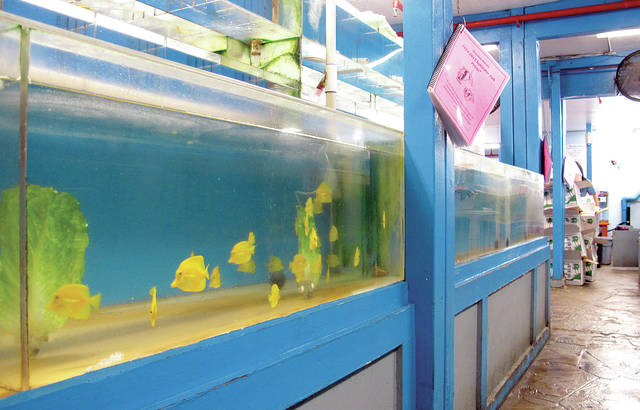KAILUA-KONA — Conservation groups hope there will be plenty of fish in the sea following another legal victory against the Department of Land and Resources.
The First Circuit Court, sitting as the Environmental Court, ruled that all unexpired recreational aquarium collection permits are void.
The April 12 ruling invalidates around 131 permits. Each permit authorized the recreational capture of almost 2,000 fish each year for a total of around 250,000 fish per year.
“We’re happy those permits are voided because they were issued illegally,” said Summer Kupau-Odo, Earthjustice attorney who represented the plaintiffs in the lawsuit. “DLNR didn’t even bother to ask what each applicant intended to do with the permit. It could have been a rare species or from a distressed reef. We don’t know because DLNR didn’t care to find out.”
Kapau-Odo added that though there may be a cap of 2,000 fish per recreational aquarium collection permit, there isn’t a law that limits the number of the permits issued by the state.
The permits were deemed illegal, the court ruled, due to their failure to comply with The Hawaii Environmental Policy Act and examine environmental consequences before issuing permits.
The now-voided permits were issued automatically via an online process. Applicants were not required to describe the fish they planned to catch, how many, or where they intended to collect the animals.
The ruling was the latest win for Earthjusice, an environmental law firm that represented plaintiffs Rene Umberger, Mike Nakachi, Ka’imi Kaupiko, Willie Kaupiko, Conservation Council for Hawaii, The Humane Society of the United States, and the Center for Biological Diversity.
The battles began in 2012, when the plaintiffs sued the DLNR for failing to comply with the Hawaii EPA and study environmental impacts before issuing aquarium collection permits.
In September 2017, The Hawaii Supreme Court sided with the plaintiffs, ruling an environmental review necessary before the DNLR can issue commercial aquarium collection permits. After the September ruling, State Circuit Judge Jeffrey P. Crabtree terminated and canceled all fine mesh net permits.
The Circuit Court in October 2017 declared all existing commercial permits void and ordered an injunction. The injunction prohibited the department from issuing new commercial permits until it complied with the EPA.
On Jan. 5, the DLNR announced an indefinite halt to all commercial aquarium fishing throughout West Hawaii pending results of an environmental review. The decision to prohibit commercial aquarium fishing occurred when the Supreme Court’s ruling was applied to an existing department rule stating a permit is required to engage in the fishing.
Until the April 12 decision, the legality of recreational aquarium collection permits remained in question.
Now it’s out of the courts and up to the DLNR to review and revamp the aquarium fishing permits.
“It’s in the DNLR’s hands to study the impact of both recreational and commercial permits,” Kapau-Odo said.
“What they need I think requires an overhaul of aquarium fish permitting in Hawaii. Right now DLNR is just letting the industry run its show. It needs to embrace its legal duty to conserve our resources to come up with a program that takes into account all stakeholders,” she added.
In response to the Supreme Court’s rulings, the DLNR is developing environmental assessments (EAs). DLNR has submitted the documents to the Office of Environmental Quality Control for dissemination and public comment.
“If significant impacts are found in the EA, then an Environmental Impact Statement (EIS) will be necessary as required in Chapter 343,” DLNR said in a statement to West Hawaii Today.
Aquarium fish collectors have prepared two separate EAs, one for the aquarium fishery on the Big Island and another for the aquarium fishery on Oahu.
No data is being collected on the other islands, as there is no significant aquarium fish collection on Kauai, Molokai, Maui, or Lanai at this time.
Results from the EAs have been met with both scrutiny and approval.
Some believe that the EAs lack the depth and analysis necessary to draw conclusions about the environmental impact of aquarium fishing practices.
“Hawaii law requires identification of cumulative and secondary impacts, including long-term effects, of the industry’s massive mining of reef animals. The EAs, however, do not discuss any effects beyond a one-year period. That’s a glaring and troubling legal flaw, which prevents DLNR from finding no significant impact,” said Kupau-Odo in a press release from the Humane Society of the United States.
But others think the EAs provide adequate proof that Hawaii’s aquarium fishing practices are sustainable.
David Tarnas, former state representative, is one who finds it sustainable. The former representative crafted legislation creating marine protection areas around 20 years ago.
“The data has shown, in my opinion, that the impact of aquarium fish collection, I find acceptable. And it is a sustained fishery because of the marine protection areas established on the coast.”
According to Tarnas, also essential to making the practice sustainable are species specific restrictions and mooring buoys not dropping anchor, both of which result in damage to marine life. Tarnas said both of the preceding measures are set in place in West Hawaii.
“I am eager to see the results of the public comments of the draft EA,” said Tarnas.

